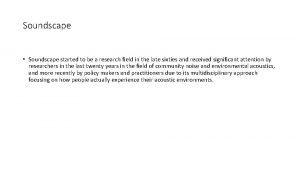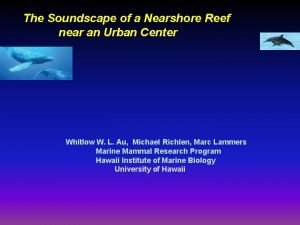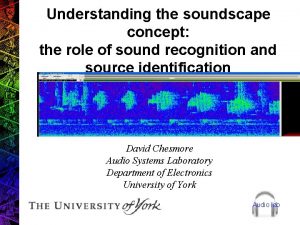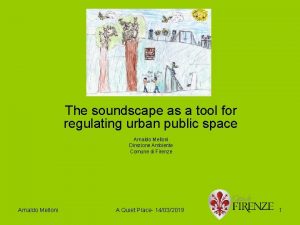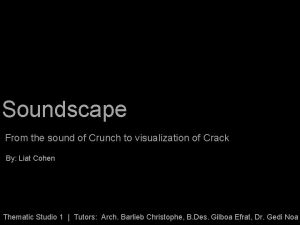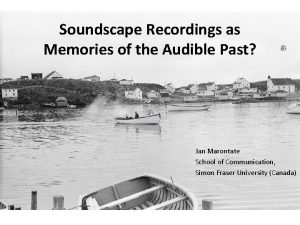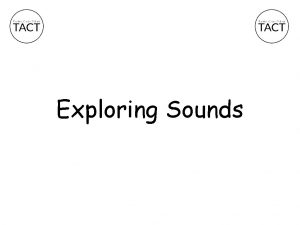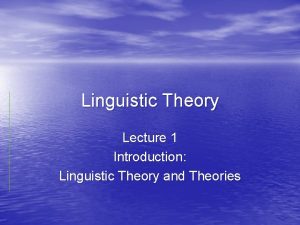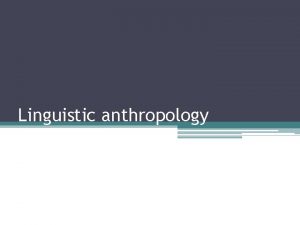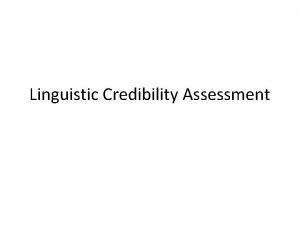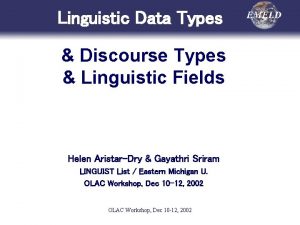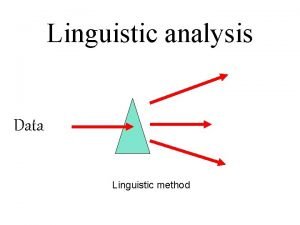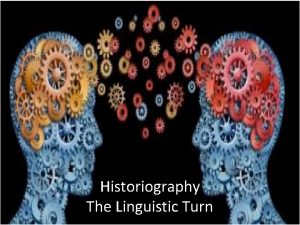CODECHOICE AND THE LINGUISTIC SOUNDSCAPE LINGUISTIC PRACTICES IN




















- Slides: 20

CODE-CHOICE AND THE LINGUISTIC SOUNDSCAPE LINGUISTIC PRACTICES IN A BILINGUAL ENGLISH / GAELIC TOWN GLOSOC 2 – Globalising Sociolinguistics – Communicating in the city December 2018 Dr Inge Birnie Ingeborg. birnie@strath. ac. uk @Dr. Inge. Birnie

GAELIC IN SCOTLAND • Minority language • 56, 000 people able to speak Gaelic across Scotland (1. 1% of the population) (National Census of 2011)

“runaway language shift” (Mac. Kinnon, 2006) ‘aside, perhaps, from very small children who are being raised through the medium of Gaelic, all Gaelic speakers are bilingual in Gaelic and English’ (Dunbar, 2011: 152) English has become the ‘unmarked code-choice’ in public domain interactions (Nic. Aoidh, 2006) ‘Only Gaelic speakers are expected to be bilingual; they expect and are expected to use the dominant language of the community’ (Munro et al, 2011: 6) WHAT DO WE KNOW?

No indication of the frequency of use No indication of the domains of use No indication of the level of inter-generational transmission No indication of the role of the language in public life “KNOWN UNKNOWNS”:

STUDY AIMS 1 Establish the link between reported linguistic competences and de facto language use. 2 Identify the domains of language use. 3 Establish the sociolinguistic patterns of language use. 4 Establish the role of Gaelic in public life in the community

STUDY LOCATION

STORNOWAY • Population of approximately 12, 500 (of which 6, 500 in the town) • 43. 4% of the population can speak Gaelic (2011 Census) • The only “urban” settlement in Scotland where a significant population can speak Gaelic • Considered to be the “least Gaelic” parish in the Western Isles

SPOKEN LANGUAGE USE Assessment of de facto use of spoken Gaelic through: ‘Spoken language use is the most natural use of language. It is the most direct kind of linguistic interaction between two or more individuals. Spoken language is also characterised by spontaneous improvisation. The choice of spoken language is often a reflex action rather than a result of reflexion’ (Altuna & Basuro, 2013: 28) • Linguistic soundscape observations in public domains • Language use diaries of Gaelic speakers Linguistic soundscape (based on the concept of linguistic landscape (Bourhis & Landry, 1997) - the audibility and salience of a spoken language in a given space, with the extent to which a particular language is used as an indication of the vitality of that language in that speech community.

METHODO LOG Y • Years of assimilation might have resulted in limited use of Gaelic in public spaces • ”Reporting bias” or ‘phenomenon of misplaced scale’ (Urla, 2013: 7) • Political and social circumstances might influence how speakers report the use of the language (Bourhis & Sachdev, 1984)

LINGUISTIC SOUNDSCAPE Number of conversations 182 • 2000 conversations recorded on the observation sheet across 10 different spaces • Gaelic used in 9. 1% of the observed conversations (182 / 2000) • 405 / 4563 participants in the conversations used Gaelic 1818 Gaelic English

Percentage Gaelic language use by members of the public according to demographic profile 35. 0 33. 0 GAELIC INTERACTIONS – DEMOGRAPHIC PROFILE • 25. 0 Gaelic more frequently used by the > 60 age categories Males (except in the < 30 category) more likely to have been observed speaking Gaelic Percentage Gaelic use • 30. 0 20. 1 20. 0 15. 0 10. 6 • Implications for language transmission / language use in public domain? ? ? 10. 0 6. 7 5. 0 3. 5 2. 2 0. 0 Adults < 30 Adults 30 - 60 Male Female n = 2, 877 Adults > 60

Percentage Gaelic 16 14. 7 14 LANGUAG E CHOICE BY GROUP OF SPEAKERS 12 10. 9 10 8 6 3. 5 4 2 0 Members of staff Members of the public Mixed participants

PERCENT A GE GAELIC BY GRO UP OF SPEAKERS AND PURPOSE Percentage Gaelic language use and purpose in conversations involving at least one member of staff 18 • Private conversations – all other interactions • All interactions involving only members of the public are ‘private’ - (14. 7%) 15. 8 16 14. 7 14 Percentage Gaelic language use • Business transactions – conversations directly related to the provisions of the goods & services of the organisation 17. 0 12 9. 8 10 8 6 4. 3 4 2. 3 2 0 Overall Members of staff Business Private Mixed participants

METHODOLOGY • Individual linguistic practices of bilinguals • Same unit of measurement as the public language use surveys • Conversation: Face-to-face spoken interaction between two or more individuals which extends beyond an initial greeting. Delineated by change in participants, change in language or change in purpose

LANGUAGE USE DIARIES Percentage language use • 12 Informants • 6 L 1 & 6 L 2 • 7 employed in the Gaelic sector, 2 involved in (Gaelic) education 472 eligible conversations 47. 5 52. 5 • 242 Gaelic conversations • No difference in frequency of Gaelic language use between L 1 & L 2 speakers Gaelic English

LANGUAGE USE DIARIES Percentage Gaelic use 100 92. 3 90 Analysis according to 4 domains: “ the public domain refers to everything connected with ordinary social interactions (business and administrative bodies, public services, cultural and leisure activities of a public nature, relations with the media, etc. ). Complementarily, the private domain comprises family relations and individual social practices. The occupational domain embraces everything concerned with a person’s activities and relations in the exercise of his or her occupation. The educational domain is concerned with the learning / training context (generally of an institutional nature is to acquire specific knowledge or skills” (the Council of Europe, 2001: 15) (Emphasis and italics by the Council of Europe). 80 70 58. 8 60 50 45. 1 40 30 24. 1 20 10 0 Private Occupational Public Educational

PRIVATE DOMAINS • Established language norms • Language use greatest in interactions involving older generations • Education as the prime acquisition mechanism for Gaelic • Everyone in my family can speak Gaelic, my brothers and my parents can all speak Gaelic. They have had Gaelic all their lives. I was brought up speaking Gaelic as my first language and my brother did as well … I never speak to my brother in Gaelic. Well, when we were younger I suppose we spoke Gaelic a lot more than we do now, but I suppose it is because all of my friends won’t have Gaelic … When we are all (= parents and brother (IB)) talking together, we talk in Gaelic but probably if my parents weren’t there, then all would be in English (Transcript BP 06_01 from interview with Informant BP 06). • People of my own age won’t speak Gaelic to each other, so, I couldn’t speak English to my parents. It is strange. I couldn’t. It is just strange to speak English to them (Translation of Transcript BP 09_01 with informant BP 09). • My husband does not speak Gaelic but I have two young daughters and a young son, they do Gaelic at school, so no, I don’t use Gaelic at all, but we sent them to the Gaelic school, we want them to have Gaelic (Translation of transcript BP 10_01 from interview with Informant BP 10).

PUBLIC DOMAIN • English the unmarked code choice • Gaelic is a marked code-choice that requires careful negotiation • Personal confidence & ideology • I won’t speak Gaelic really to people in the shops … I don’t know if someone in Tesco or the Coop speaks Gaelic, something like that, so, I don’t speak Gaelic to them at all (Translation of transcript BP 10_03). • You have to ask people “Do you speak Gaelic”, so I asked this woman. I thought for a while that perhaps she spoke Gaelic, so, when I was confident, when I was feeling confident enough, I started. I didn’t want … I am not speaking to someone anyway, I don’t want to go “Do you speak Gaelic” but she was speaking a bit about the weather, and I thought “ooh this is a chance” because we had a bit of a conversation. Often this woman doesn’t say a lot, so, she just gives you change and she doesn’t speak, but because we had a wee chat I thought I would ask. We started in English and then I asked, “Do you have Gaelic? ”, and she said; “Yes plenty”, and I asked, “Would you be willing to speak to me in Gaelic? ” And she said, “oh yes”. I thought that was good… I don’t want, I don’t put someone in an embarrassing situation (Translation of Transcript BP 01_02).

o Inertia condition of language choice (Spolsky & Cooper, 1991) o ‘Spoken language is by nature a collective matter. Oral use of a language does not depend on the individual, but on the group’ (Altuna & Basurto, 2013: 74) CONCLUS IONS o Linguistic soundscape created by members of staff in a location appears to be a contributing factor in the use & perception of Gaelic. o (Re-)negotiating language norm is a gradual and sensitive process requiring an explicit offer on the part of the service provider (Heller, 1978)

“I DON’T KNOW (WHAT I THINK ABOUT GAELIC – IB). I DON’T KNOW. TO TELL THE TRUTH I DON’T KNOW WHAT I THINK ABOUT GAELIC, ALTHOUGH I WORK HERE (IN A GAELIC SECTOR WORKPLACE – IB), I HAVE CHILDREN IN THE GAELIC SCHOOL. I LIKE GAELIC, BUT I AM NOT … I AM NOT OVERLY PASSIONATE ABOUT IT. I AM NOT AN ACTIVIST. I DON’T THINK ABOUT IT, I SPEAK GAELIC, JUST LIKE I SPEAK ENGLISH. I DON’T THINK ABOUT IT” Taing mhòr! Thank you! Dank u wel! (TRANSLATION OF TRANSCRIPT WITH INFORMANT BP 10_03 (FEMALE, 30 – 60, EMPLOYED IN THE GAELIC SECTOR). Ingeborg. birnie@strath. ac. uk
 Hình ảnh bộ gõ cơ thể búng tay
Hình ảnh bộ gõ cơ thể búng tay Lp html
Lp html Bổ thể
Bổ thể Tỉ lệ cơ thể trẻ em
Tỉ lệ cơ thể trẻ em Chó sói
Chó sói Tư thế worm breton
Tư thế worm breton Hát lên người ơi
Hát lên người ơi Môn thể thao bắt đầu bằng từ chạy
Môn thể thao bắt đầu bằng từ chạy Thế nào là hệ số cao nhất
Thế nào là hệ số cao nhất Các châu lục và đại dương trên thế giới
Các châu lục và đại dương trên thế giới Công thức tính thế năng
Công thức tính thế năng Trời xanh đây là của chúng ta thể thơ
Trời xanh đây là của chúng ta thể thơ Mật thư tọa độ 5x5
Mật thư tọa độ 5x5 101012 bằng
101012 bằng độ dài liên kết
độ dài liên kết Các châu lục và đại dương trên thế giới
Các châu lục và đại dương trên thế giới Thơ thất ngôn tứ tuyệt đường luật
Thơ thất ngôn tứ tuyệt đường luật Quá trình desamine hóa có thể tạo ra
Quá trình desamine hóa có thể tạo ra Một số thể thơ truyền thống
Một số thể thơ truyền thống Cái miệng nó xinh thế chỉ nói điều hay thôi
Cái miệng nó xinh thế chỉ nói điều hay thôi Vẽ hình chiếu vuông góc của vật thể sau
Vẽ hình chiếu vuông góc của vật thể sau





















